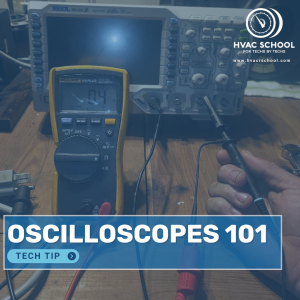Tech Tips

This tech tip is based on a podcast episode with Bill Nowicki about the latest DHS guidance on HVAC use in nuclear emergencies. You can listen to that podcast HERE. Bill has 45 years of experience in the nuclear industry, starting with his Naval career, and he also has a few podcasts of his own. […]
Read more

As the HVAC industry transitions to refrigerants with lower global warming potential (GWP), A2L refrigerants like R-454B are becoming more common. These refrigerants are classified as “mildly flammable” and require the installation of A2L leak detection sensors in many applications to ensure safety. While these sensors are essential for detecting actual refrigerant leaks, HVAC technicians […]
Read more

This tech tip is the final installment in our short series on using oscilloscopes to troubleshoot communicating systems. Imagine this scenario: you've got a refrigeration system acting up, and the comms network, whether it's LON or MOD-bus, seems a bit flaky. Let me introduce you to oscilloscopes—more specifically, a PC version called the PicoScope 2204A. […]
Read more

This tech tip about preventing heat illnesses covers information and resources from the Cleveland Clinic, the U.S. Centers for Disease Control and Prevention (CDC), the U.S. Occupational Safety and Health Administration (OSHA), and the National Oceanic and Atmospheric Administration (NOAA). HVAC School is NOT an official OSHA training resource, and although these safety tips are […]
Read more

This tech tip about RS-485 communication is the third installment in a four-part series about oscilloscopes. It's a primer for the final installment about using an oscilloscope for diagnosis. I owe a special thanks to Jeremy Smith for sharing the information on Danfoss and for sparking my curiosity surrounding this type of communication. Let's talk […]
Read more

The HVAC industry's ongoing shift towards eco-friendly solutions continually introduces new challenges and learning opportunities. A2L refrigerants are at the forefront of this transformation, offering a lower global warming potential (GWP) than many of the refrigerants we’ve been using. They’re also mildly flammable, meaning they require some enhanced safety measures. One of these is the […]
Read more

This is part two of our four-part series on oscilloscope fundamentals. Special thanks to Andrew Holden for his contributions. In our last tech tip on oscilloscopes, we learned about some safety basics, waveforms, and measurements. We’re going to dive a little deeper into systems and settings on the oscilloscope in this tech tip. Systems are […]
Read more

Every trade has its favorite phrases. One of the most common in HVAC goes something like: “I’ve been doing it this way for 20 years and never had a problem.” When you hear that—or when you catch yourself saying it—it’s worth stopping to think. Usually, what that sentence really means is: “I’ve been doing it […]
Read more

This tech tip is the first in a four-part series on using oscilloscopes. I'd like to give a special thanks to Andrew Holden for his contributions to this particular tech tip. When we want to measure voltage between two points, we reach for a multimeter. A multimeter can tell us the average electrical potential between […]
Read more







